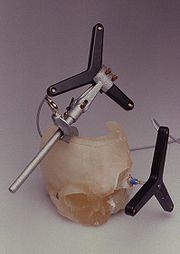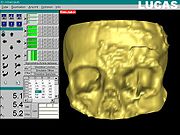
Surgical planning
Encyclopedia



Bone segment navigation
Bone segment navigation is a surgical method used in the field to find the anatomical position of displaced bone fragments in fractures, allowing a good fixation by osteosynthesis. It has been developed for the first time in oral and maxillofacial surgery....
in the context of computer assisted surgery
Computer assisted surgery
Computer assisted surgery represents a surgical concept and set of methods, that use computer technology for presurgical planning, and for guiding or performing surgical interventions...
.
The surgical planning is most important in neurosurgery
Neurosurgery
Neurosurgery is the medical specialty concerned with the prevention, diagnosis, treatment, and rehabilitation of disorders which affect any portion of the nervous system including the brain, spine, spinal cord, peripheral nerves, and extra-cranial cerebrovascular system.-In the United States:In...
and oral and maxillofacial surgery
Oral and maxillofacial surgery
Oral and maxillofacial surgery is surgery to correct a wide spectrum of diseases, injuries and defects in the head, neck, face, jaws and the hard and soft tissues of the oral and maxillofacial region. It is an internationally recognized surgical specialty...
. The transfer of the surgical planning to the patient is generally made using a medical navigation system
Surgical Segment Navigator
The Surgical Segment Navigator is a computer-based system for use in surgical navigation. It is integrated into a common platform, together with the Surgical Tool Navigator , the Surgical Microscope Navigator and the 6DOF Manipulator , developed by Carl Zeiss.- SSN :The SSN has been developed as...
.
Principles of surgical planning
The imagistic dataset used for surgical planning is mainly based on a CTComputed tomography
X-ray computed tomography or Computer tomography , is a medical imaging method employing tomography created by computer processing...
or MRI. In oral and maxillofacial surgery
Oral and maxillofacial surgery
Oral and maxillofacial surgery is surgery to correct a wide spectrum of diseases, injuries and defects in the head, neck, face, jaws and the hard and soft tissues of the oral and maxillofacial region. It is an internationally recognized surgical specialty...
, a different, more "traditional" surgical planning can be used for orthognatic surgery, based on cast models fixed into an articulator
Articulator
An articulator is a mechanical device used in dentistry to which casts of the maxillary and mandibular teeth are fixed, reproducing recorded positions of the mandible in relation to the maxilla...
.
History of the concept
In order to make a surgical planning, one would need a 3DThree-dimensional space
Three-dimensional space is a geometric 3-parameters model of the physical universe in which we live. These three dimensions are commonly called length, width, and depth , although any three directions can be chosen, provided that they do not lie in the same plane.In physics and mathematics, a...
image of the patient. The starting point was made by G. Hounsfield
Godfrey Hounsfield
Sir Godfrey Newbold Hounsfield CBE, FRS, was an English electrical engineer who shared the 1979 Nobel Prize for Physiology or Medicine with Allan McLeod Cormack for his part in developing the diagnostic technique of X-ray computed tomography .His name is immortalised in the Hounsfield scale, a...
in the 1970s, by using CT
Computed tomography
X-ray computed tomography or Computer tomography , is a medical imaging method employing tomography created by computer processing...
in order to record data about the anatomical situation of the patients. In the 1980s, advances were made by the radiologist M. Vannier
Michael W. Vannier
Michael W. Vannier is a radiologist in Chicago.On July 19, 1983, M. Vannier and his co-workers J. Marsh and J...
and his team, by creating the first computed three-dimensional reconstruction from a CT
Computed tomography
X-ray computed tomography or Computer tomography , is a medical imaging method employing tomography created by computer processing...
dataset. In the early 1990s, the surgical planning was performed by using stereolithographic models
Stereolithography (medicine)
Stereolithographic models have been used in medicine since the 1990s, for creating 3D corporeal models of various anatomical regions of a patient, based on datasets from CT-scans.- Usage :...
. During the late 1990s, the first full computer-based
Laboratory Unit for Computer Assisted Surgery
Laboratory Unit for Computer Assisted Surgery is a system used for virtual surgical planning. Starting with 1998, LUCAS was developed at the University of Regensburg, Germany, with the support of the Carl Zeiss Company. The resulting surgical planning is then reproduced onto the patient by using a...
virtual surgical planning was made for osteotomies
Osteotomy
An osteotomy is a surgical operation whereby a bone is cut to shorten, lengthen, or change its alignment. It is sometimes performed to correct a hallux valgus, or to straighten a bone that has healed crookedly following a fracture. It is also used to correct a coxa vara, genu valgum, and genu varum...
, and then transferred to the operating theatre by a navigation system
Surgical Segment Navigator
The Surgical Segment Navigator is a computer-based system for use in surgical navigation. It is integrated into a common platform, together with the Surgical Tool Navigator , the Surgical Microscope Navigator and the 6DOF Manipulator , developed by Carl Zeiss.- SSN :The SSN has been developed as...
..

